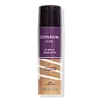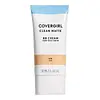Covergirl + Olay Simply Ageless 3-In-1 Liquid Foundation Versus Covergirl Clean Matte BB Cream For Oily Skin
What's inside
What's inside
 Key Ingredients
Key Ingredients

 Benefits
Benefits

 Concerns
Concerns

 Ingredients Side-by-side
Ingredients Side-by-side

Cyclopentasiloxane
EmollientWater
Skin ConditioningGlycerin
HumectantDimethicone Crosspolymer
Emulsion StabilisingSodium Chloride
MaskingAcetyl Glucosamine
Skin ConditioningDiethylhexyl Carbonate
EmollientNiacinamide
SmoothingEthylhexyl Methoxycinnamate
UV AbsorberTalc
AbrasivePEG/PPG-18/18 Dimethicone
EmulsifyingPanthenol
Skin ConditioningPalmitoyl Pentapeptide-4
Skin ConditioningTocopheryl Acetate
AntioxidantAllantoin
Skin ConditioningMethicone
EmollientAluminum Hydroxide
EmollientBenzyl Alcohol
PerfumingCamellia Sinensis Leaf Extract
AntimicrobialPEG-10 Dimethicone Crosspolymer
StabilisingMethylparaben
PreservativeEthylparaben
PreservativePropylparaben
PreservativeDisodium EDTA
Parfum
MaskingPEG-100 Stearate
Titanium Dioxide
Cosmetic ColorantIron Oxides
Cyclopentasiloxane, Water, Glycerin, Dimethicone Crosspolymer, Sodium Chloride, Acetyl Glucosamine, Diethylhexyl Carbonate, Niacinamide, Ethylhexyl Methoxycinnamate, Talc, PEG/PPG-18/18 Dimethicone, Panthenol, Palmitoyl Pentapeptide-4, Tocopheryl Acetate, Allantoin, Methicone, Aluminum Hydroxide, Benzyl Alcohol, Camellia Sinensis Leaf Extract, PEG-10 Dimethicone Crosspolymer, Methylparaben, Ethylparaben, Propylparaben, Disodium EDTA, Parfum, PEG-100 Stearate, Titanium Dioxide, Iron Oxides
Water
Skin ConditioningCyclopentasiloxane
EmollientPropylene Glycol
HumectantTalc
AbrasiveDimethicone
EmollientAluminum Starch Octenylsuccinate
AbsorbentSodium Chloride
MaskingPEG/PPG-18/18 Dimethicone
EmulsifyingPvp
Emulsion StabilisingBenzyl Alcohol
PerfumingSilica
AbrasivePhenoxyethanol
PreservativeEthylene/Methacrylate Copolymer
Synthetic Beeswax
Emulsion StabilisingTrihydroxystearin
Skin ConditioningMethicone
EmollientSodium Benzoate
MaskingSynthetic Wax
AbrasivePolyglyceryl-4 Isostearate
EmulsifyingCetyl PEG/PPG-10/1 Dimethicone
EmulsifyingHexyl Laurate
EmollientIsopropyl Titanium Triisostearate
EmollientEthylene Brassylate
MaskingPolyethylene
AbrasiveCI 77891
Cosmetic ColorantCI 77491
Cosmetic ColorantCI 77492
Cosmetic ColorantCI 77499
Cosmetic ColorantWater, Cyclopentasiloxane, Propylene Glycol, Talc, Dimethicone, Aluminum Starch Octenylsuccinate, Sodium Chloride, PEG/PPG-18/18 Dimethicone, Pvp, Benzyl Alcohol, Silica, Phenoxyethanol, Ethylene/Methacrylate Copolymer, Synthetic Beeswax, Trihydroxystearin, Methicone, Sodium Benzoate, Synthetic Wax, Polyglyceryl-4 Isostearate, Cetyl PEG/PPG-10/1 Dimethicone, Hexyl Laurate, Isopropyl Titanium Triisostearate, Ethylene Brassylate, Polyethylene, CI 77891, CI 77491, CI 77492, CI 77499
Ingredients Explained
These ingredients are found in both products.
Ingredients higher up in an ingredient list are typically present in a larger amount.
Benzyl Alcohol is most commonly used as a preservative. It also has a subtle, sweet smell. Small amounts of Benzyl Alcohol is not irritating and safe to use in skincare products. Most Benzyl Alcohol is derived from fruits such as apricots.
Benzyl Alcohol has both antibacterial and antioxidant properties. These properties help lengthen the shelf life of products. Benzyl Alcohol is a solvent and helps dissolve other ingredients. It can also improve the texture and spreadability.
Alcohol comes in many different forms. Different types of alcohol will have different effects on skin. This ingredient is an astringent alcohol.
Using high concentrations of these alcohols are drying on the skin. They may strip away your skin's natural oils and even damage your skin barrier. Astringent alcohols may also irritate skin.
Other types of astringent alcohols include:
According to the National Rosacea Society based in the US, you should be mindful of products with these alcohols in the top half of ingredients.
Any type of sanitizing product will have high amounts of alcohol to help kill bacteria and viruses.
Learn more about Benzyl AlcoholCyclopentasiloxane, or D5, is a silicone used to improve texture of products and trap moisture.
D5 is considered lightweight and volatile. Volatile means it evaporates quickly after application. Once evaporated, D5 leaves a thin barrier that helps keep skin hydrated.
It is also an emollient. Emollients help soften the skin and prevent water loss. Silicones create a silky texture in products. D5 helps other ingredients become more spreadable.
Studies show D5 is safe to use in skincare products. We recommend speaking with a skincare professional if you have concerns.
Learn more about CyclopentasiloxaneMethicone is a type of silicone and is a simpler form of dimethicone.
Silicones are used to enhance the texture of products and have emollient properties. Methicone is used to give products a silky texture and improves spreadability.
PEG/PPG-18/18 Dimethicone is a type of silicone.
Chances are, you eat sodium chloride every day. Sodium Chloride is also known as table salt.
This ingredient has many purposes in skincare: thickener, emulsifier, and exfoliator.
You'll most likely find this ingredient in cleansers where it is used to create a gel-like texture. As an emulsifier, it also prevents ingredients from separating.
There is much debate on whether this ingredient is comedogenic. The short answer - comedogenic ratings don't tell the whole story. Learn more about comegodenic ratings here.
The concensus about this ingredient causing acne seems to be divided. Research is needed to understand if this ingredient does cause acne.
Scrubs may use salt as the primary exfoliating ingredient.
Learn more about Sodium ChlorideTalc is a clay mineral. It helps absorb moisture and improve the texture of products. Like other types of clay, Talc can have a slight exfoliating effect on skin. Talc can be added to increase the volume of products.
Some Baby powders are made by combining talc with corn starch. The word "talc" comes from Latin and originates from Arabic. Talc is a mineral commonly found throughout the world.
If you have any concerns about using talc, we recommend checking out the FDA's official page.
Learn more about TalcWater. It's the most common cosmetic ingredient of all. You'll usually see it at the top of ingredient lists, meaning that it makes up the largest part of the product.
So why is it so popular? Water most often acts as a solvent - this means that it helps dissolve other ingredients into the formulation.
You'll also recognize water as that liquid we all need to stay alive. If you see this, drink a glass of water. Stay hydrated!
Learn more about Water